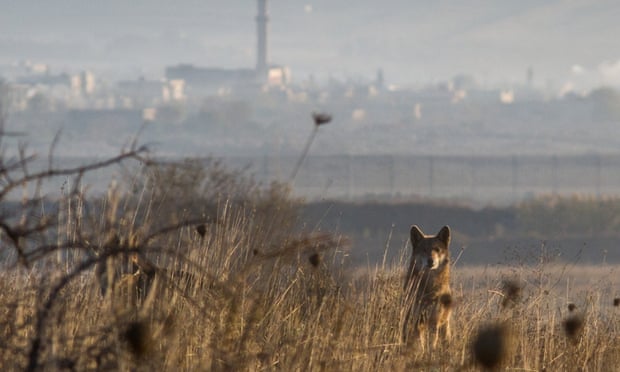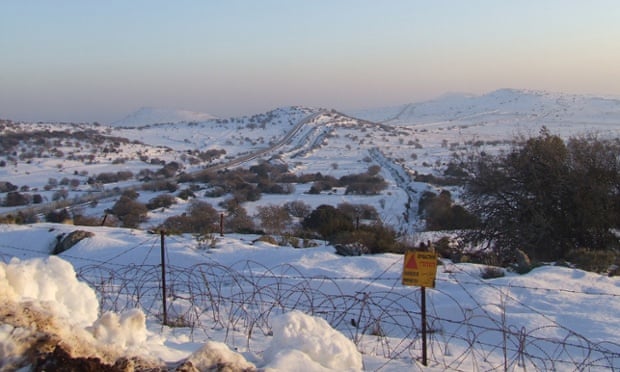Friday 6 February 2015
In the Golan Heights, a dangerous minefield provides an unlikely wildlife reserve where wolves are thriving

Caption: Matriarch of the Itamar wolf pack in the safety of the minefield. Her mate stands behind the shrub, and behind her is the fenced Israeli border overlooking the Syrian town of Quneitra. Photograph: Itamar Yairi
Sitting in the cold of an open jeep, we are waiting for dawn. The thick snow provides some reflective light and we strain our eyes, hoping to catch a glimpse of the wolf pack as they return home from their night’s hunt. This family of wolves holds one of the safest territories a large predator could possibly hope for: a minefield in the Golan Heights, near the Israel-Syria border.
One step outside the barbed-wire fence, however, and the wolves must be very careful. Although wolves are provided with substantial legal protection from the Israel Nature and Parks Authority (INPA) – enabling one of the greatest wolf recoveries in the world – they are hunted, culled and poached across the region. In an effort to appease ranchers who fear for their livestock while simultaneously conserving this growing wolf population, three management zones were delineated.
In the southern Golan Heights, ranchers can legally shoot wolves, and may even be rewarded with a generous bounty. Further north, wolves can also be hunted, but only by special permit issued by the INPA. Hunting wolves is forbidden inside national parks, and carries a heavy penalty, but poaching does occur occasionally, and can be difficult to enforce. Throughout the Golan, the INPA kills wolves, in a controversial effort to limit their population.
Itamar Yairi, a photographer who has been closely observing the Golan wolves for the past two years, witnessed the potentially dire consequences for those who venture out of the minefields.

Photographer Itamar’s wolf pack. Photograph: Itamar Yairi
The pack Itamar follows, led by a distinctly large and beautiful matriarch, chose to conceal their pups in a den just a few meters outside the minefield’s perimeter. “They were living like royalty, completely relaxed,” Itamar tells me. “Lying in the sun all day, playing and resting, watching over their pups, and then going out under the cover of darkness to hunt.” But one morning Itamar arrived to find a tragedy. The wolves were gone, and inside the pup’s den he found a box of meat laced with poison.
Poisoning wolves is strictly illegal in Israel, but occasionally it does happen, causing extensive deaths of wolves and other wildlife including jackals, foxes, wild boar and raptors. The death of wolves is bound to ripple through every facet of the Golan ecosystem, from the gazelles and wild boar that they hunt, and the jackals that they dominate, to the entire fabric of the remnant oak woodlands.
For several months Itamar could not find his wolf pack, but slowly, one by one, some of them reappeared: the matriarch and her mate and their two adult daughters returned, but their adult son is gone, and so are the pups. “I don’t want to know what happened to them,” he says.
Wolves live in extended family units, in which only one pair reproduces and the entire pack cooperate in raising and educating the young. They hunt together, patrol their territory together, and are deeply bonded to one another. Some wolves stay with their parents well into adulthood. It is these social ties that make wolves such powerful ecological players. It is the pack – not the individual wolf – that is the apex predator.
The loss of pack members is therefore a terrible blow, both to the wolves and the ecosystem. “They haven’t fully recovered from the loss,” Itamar tells me. “I only hope that they keep their next litter of pups deep inside the minefield.”
In 2010, 11-year-old Daniel Yuval was badly injured when he accidentally wandered into a snow-covered minefield, detonating a land mine during a family hike near the village of Merom Golan. Daniel lost his leg, and his sister sustained serious injuries. The incident sparked a global campaign to clear land mines, and the Israel Defence Force (IDF) responded by improving the visibility of warning signs and fence maintenance. Landmines remain common and deadly however, and in 2013, Roi Alphi, a Combat Engineering Corps soldier, was killed during an accident in an operation to clear anti-tank mines in the southern Golan.
The landmines and the tensely patrolled militarised zone make it a dangerous and forbidding place for humans, but a sanctuary for the wolves. “I have watched the wolves running towards the minefields, only to slow down to an easy trot when they pass the fence,” Itamar explains. “If the mines go, so will the wildlife.”

The minefield overlooking the border. Trenches were formed as a defence against tanks. Photograph: Arian Wallach
As the day breaks, the sun lights the massive fence running along the Israel-Syria border. Beyond the fence we watch the sleeping Syrian town of Quneitra. There is no sign of electricity, nor is there smoke rising from a chimney. I wonder how they warm their homes on this bitterly cold morning. We can hear occasional gunfire, but Amir Drori, jeep tour guide and local resident, tells me that this is a relatively quiet day. “Its too cold to fight. We have in a way gotten used to the sound of heavy gunfire and explosions from our neighbours on the other side of the fence.”
We did not see Itamar’s pack that morning, but we did find their tracks crossing in and out of the minefield a short distance away.
• This article was amended on 6 February 2015 to remove ambiguities about the territory in which the wolf pack lives.
source


No comments:
Post a Comment